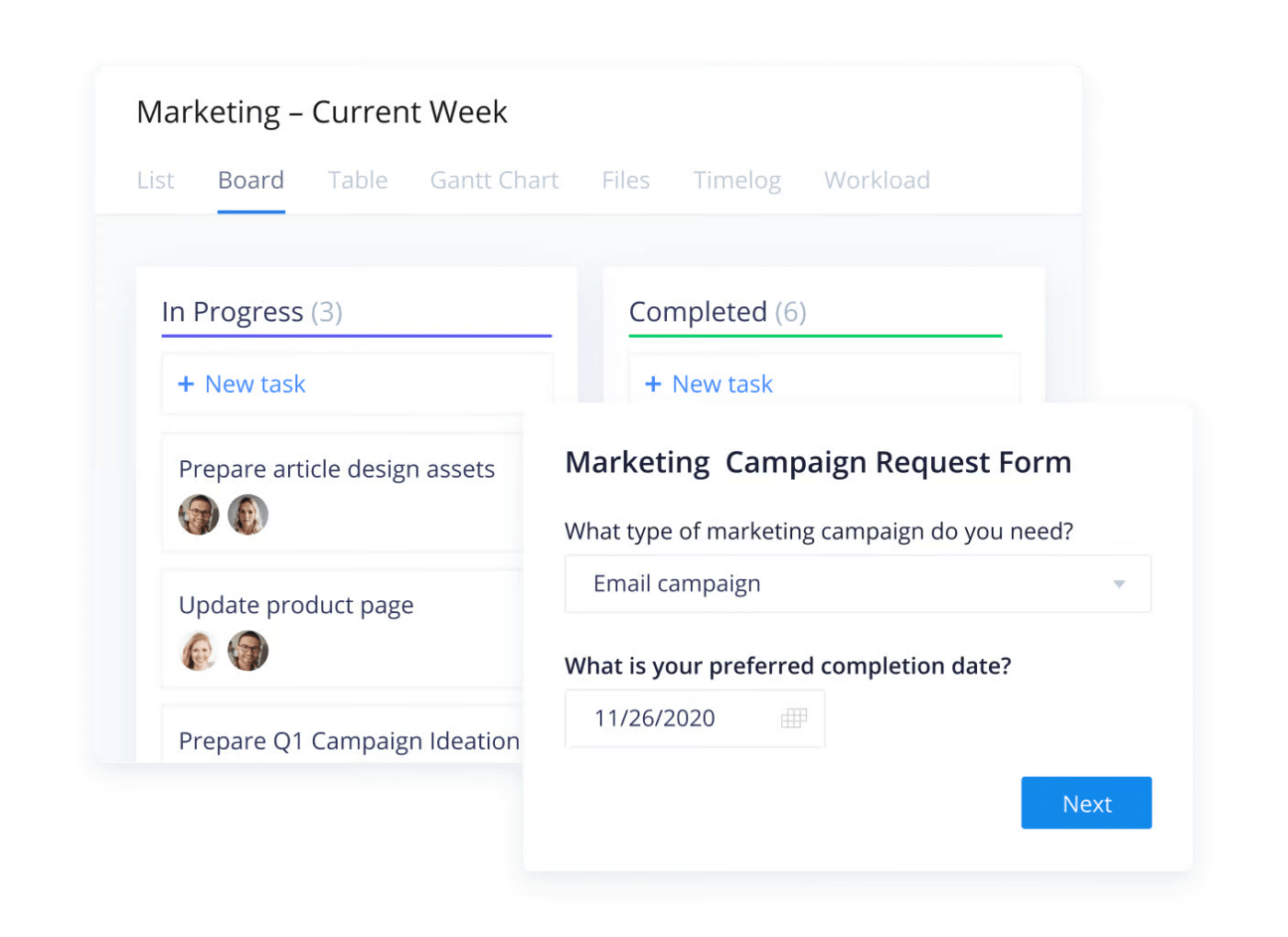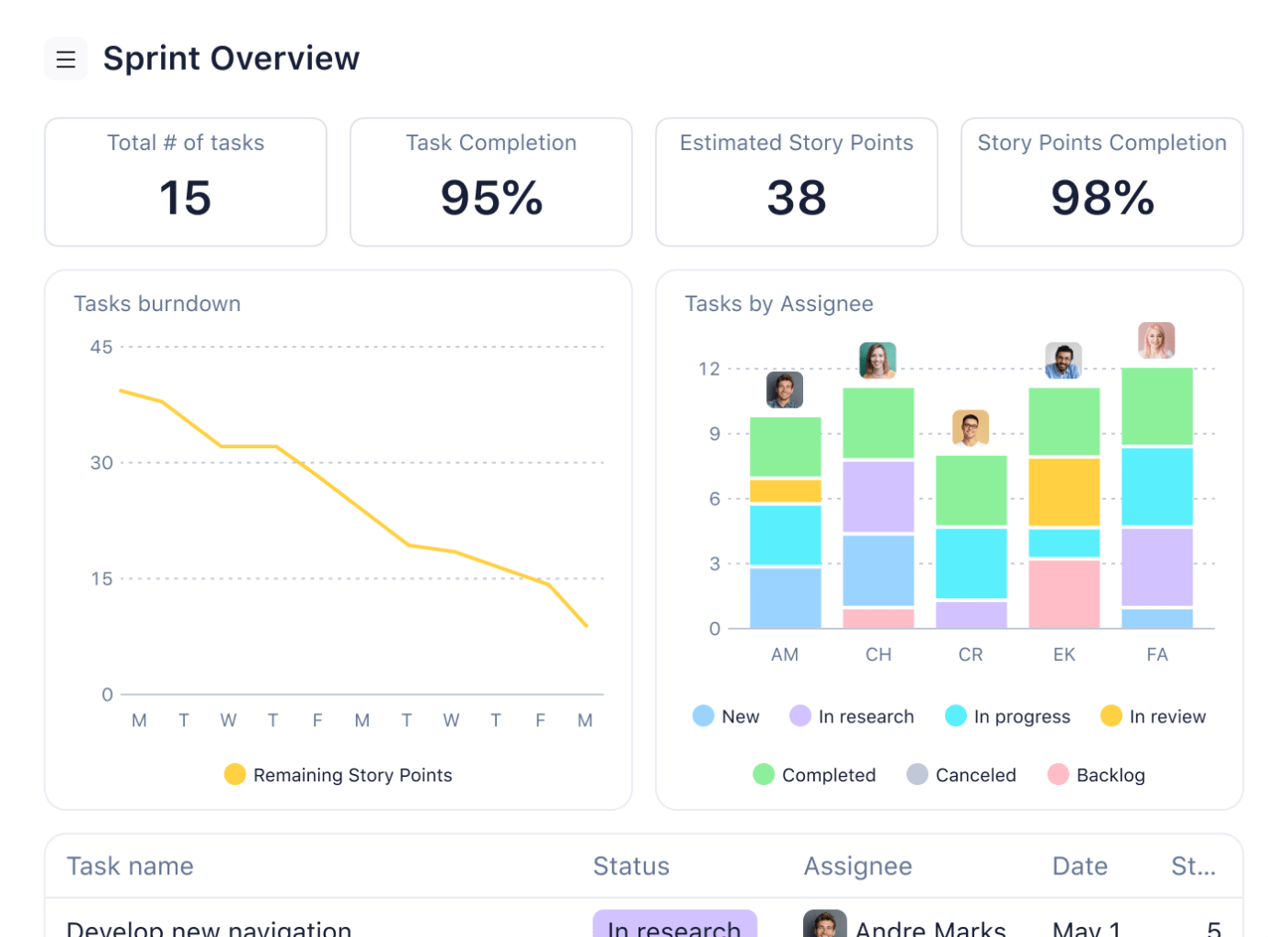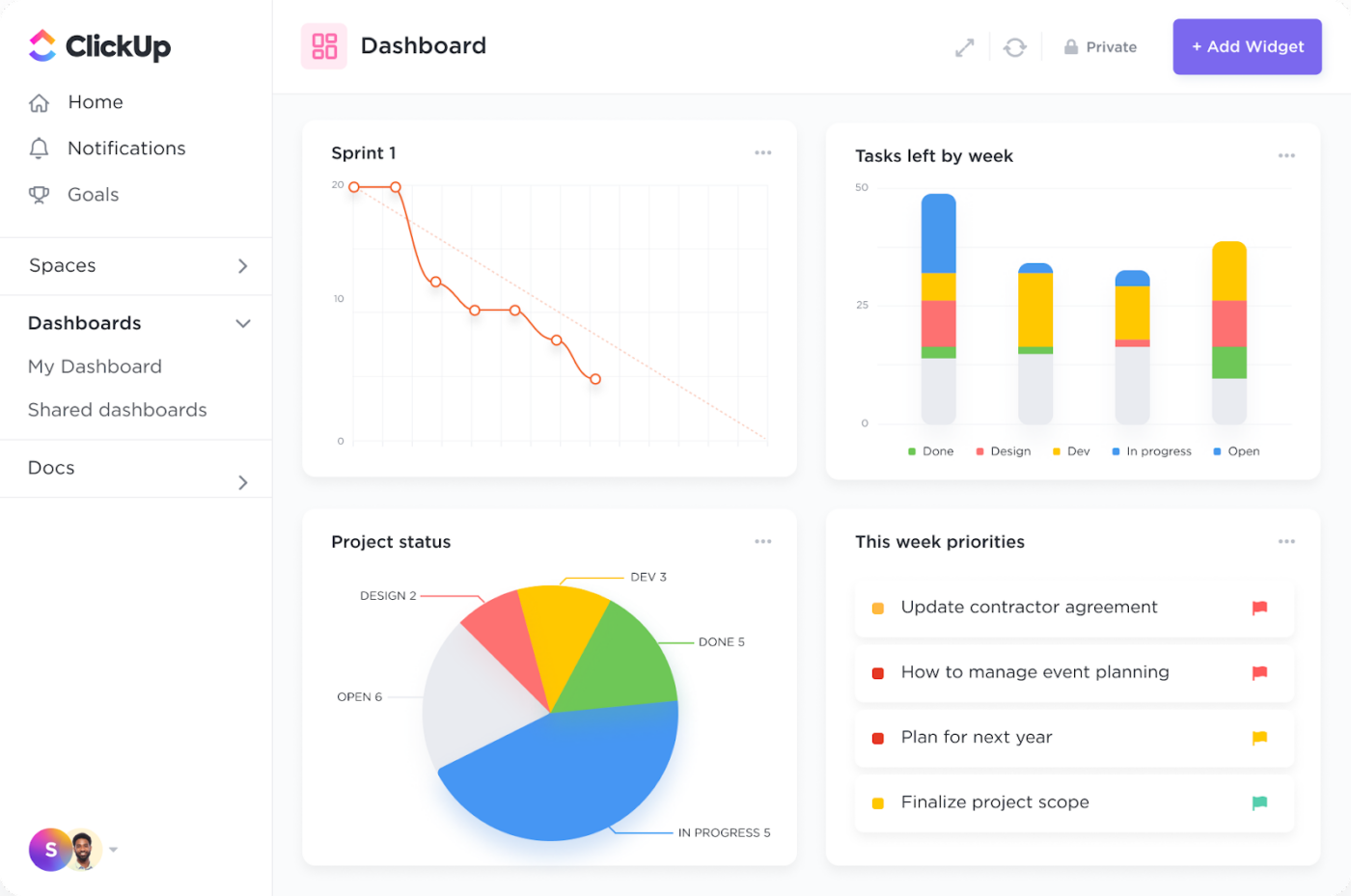Microsoft Project vs. Wrike: Which Project Management Tool Is the Best?

Sorry, there were no results found for “”
Sorry, there were no results found for “”
Sorry, there were no results found for “”
It’s impossible to juggle all the hundred things a project manager does without some assistance. You must set goals, delegate tasks, track progress, and push for great outcomes while keeping project stakeholders in the loop.
You may have won the jackpot if you’ve got a stellar team. But that alone won’t be enough. Behind every successful project manager lies a combination of the best productivity and project management tools.
But with so many great tools available, it can be hard to pick the right one.
Two excellent options are Microsoft Project and Wrike.
These platforms are two of the most sought-after tools for project managers. They offer many features for task organization, real-time team collaboration, and project monitoring.
In this blog post, we’ll explore these two software tools in detail and examine their features, pricing, and user reviews. This will help you choose the best project management software for your team.
We’ll also introduce a bonus option at the end, so stick around to find out!
Microsoft Project (aka MS Project) is a comprehensive project management tool that is part of the Microsoft 365 suite of apps. You can access it online or install it on your computer.
MS Project allows you to develop project strategies, plan timelines, assign tasks, and track progress, all within a single platform. Whether your project follows a traditional or Agile approach, the platform is flexible enough to support your needs.
Learning MS Project may take time and effort compared to its alternatives, but integrating with other Microsoft apps makes learning a great experience. It’s suitable for businesses of all sizes, offering features such as task and resource management to keep things running smoothly.
From project planning to scheduling to portfolio management, MS Project is capable of many things. Let’s take a closer look at some of its key features.
One of the standout features of MS Project is the multiple project views. You can use the Grid View to make task lists, the Board View to see workflows via a Kanban board, and Timeline Views, such as a Gantt chart, to schedule tasks over time.
With the Gantt chart, you can see your tasks’s start and end points and their dependency on each other. This helps project managers monitor project progress and ensure things stay on schedule. You can customize the Gantt chart further based on the metrics you need to visualize.
No matter which view you use, MS Project helps you stay organized and easily make changes if needed.
Keep track of all the resources needed for a project’s tasks, such as people, equipment, and materials. MS Project’s resource management features help you ensure that your resources are used optimally.
The resource leveling and allocation tools in MS Project help balance resources and make sure they’re not being overused or wasted. You can also create groups of resources to manage them more easily.
Plus, MS Project lets you track costs to help you stay within budget. You can customize it to fit your project’s needs, making it a reliable way to manage finances and resources together.
MS Project makes reporting easy with pre-made reports you can share with your team. Project managers can use these to monitor progress, budget, or resource use.
Pre-built reports are available in different types, such as graphs, pivot tables, and dashboards, allowing you to tailor them to your preferences. These reports visually show data, making it easy to spot and fix problems.

Wrike is a project management software that helps teams work together. It keeps everything organized in one place, from documents to tasks, so everyone knows what to do by when.
With customizable dashboards and advanced automation features, it’s easy to stay on top of projects and save time. Plan projects using tools such as Gantt charts, which show who’s doing what and when. Plus, it fits well with other apps you may already use, such as Google Docs or Microsoft programs.
Whether you’re a marketing team with new ideas for your product launch campaign or an engineering team looking to streamline bug reports and fixes, Wrike can help you stay organized and get things done smoothly.
As a project management solution, Wrike comes packed with many powerful features. Let’s take a look at them.

One of Wrike’s main features is its ability to create custom project request forms. With an in-built template, you can make special forms to request things for your project.
You can create custom forms with titles and questions tailored to get the necessary information, such as text input, files, and pictures.
Once someone completes the form, you can automate actions based on the responses, such as creating a new project proposal or assigning tasks. Additionally, you have control over who can view the form and who can give approval.

Wrike’s workflow automation features simplify your team’s workflow by automating repetitive tasks and actions based on predefined conditions.
You don’t need to be a tech wizard to set up workflow automation in Wrike. Just point, click, and choose from various options using drop-down menus. This user-friendly interface makes it easy for anyone to create custom automation rules tailored to their team’s needs.
Define triggers and actions for each automation rule: Automate status updates, reminders, messaging, and integrations with other tools. For instance, you can set up Wrike to send instant messages on Slack about the next steps in a project as tasks are completed.
You can also track the effectiveness of your automation rules. The automations homepage provides insights into how often each rule has been used within a month, allowing you to evaluate their impact on your team’s productivity.

Wrike’s advanced analytics not only allows you to track your projects but also lets you study your data. Use it to set up custom reports to track your progress against your goals. And the best part is that you can easily share these dashboards and reports with your team.
Wrike also has interactive widgets that make it easy to visualize important data. Just drag and drop them where you need them, and you’re good to go.
While Wrike’s analytics features may be tricky for beginners, they’re a big plus for teams with years of experience. With features like Work Intelligence AI, Wrike helps you organize your workflows and identify issues before they become big problems.
Get to know how Wrike fares against MS Project with this quick comparison:
| Feature | Microsoft Project | Wrike |
| Multiple views | Yes, including Gantt, Board, and Kanban | Yes |
| Native time-tracking | Yes | Yes |
| Automation and AI | Needs to integrate with Microsoft Power Automate to automate workflows | Has native workflow automation features and AI tools |
| Collaboration | Limited; needs to integrate with Microsoft Sharepoint and Teams | Extensive; allows commenting, tagging, and mentioning team members on tasks |
| Risk management | Has issue tracking and risk management tools | Offers AI-driven project-based health assessment |
| Reporting | Integrates with MS Excel to generate reports | Has a built-in Analytics tool for real-time updates and reports |
| Team communication | No | Free messaging within the tool |
| File sharing | No | Yes |
| Integrations | Only with Microsoft 365 tools | Integrates with 400+ apps |
| Privacy | Yes | Yes |
| Pricing | $10/month, free trial | $9.80/month, free plan |
Both MS Project and Wrike excel at project management. Let’s compare them.
MS Project helps you manage your projects efficiently. It offers tools that estimate your workload accurately and manage multiple projects simultaneously. Depending on your version, you may get access to extra features, such as a project board for organizing tasks in Kanban style.
Wrike has specialized built-in tools designed to help you finish your projects successfully. In Wrike, you can create tasks and turn them into important milestones, which can then be transformed into insightful reports using the Analytics tool. Plus, you can customize and automate your workflows within Wrike without extra software.
| MS Project or Wrike? So, if you’re looking for a tool that focuses on improving project delivery, Wrike may be the better choice for you. |
MS Project is so focused on managing projects that its collaboration tools are quite limited compared to other work management tools. While you can use other Microsoft apps, such as SharePoint and Microsoft Teams, for collaboration, MS Project doesn’t offer as many built-in collaboration features.
This limitation may prompt you to look for MS Project alternatives.
Wrike, on the other hand, is a desktop client packed with collaboration tools. You can send messages to your team, project groups, or the entire company. Plus, you get email notifications or real-time notifications on the mobile app.
| MS Project or Wrike? With features such as commenting, tagging, and mentioning team members, Wrike provides a centralized communication and task management hub, making collaboration effortless. |
MS Project integrates well with other Microsoft Office 365 tools, such as Outlook, making sending task updates to your team easy. Since many people are familiar with Microsoft products, setting up these integrations is usually straightforward.
On the other hand, Wrike offers over 400 pre-built integrations, including those with popular tools such as Power BI, Google Sheets, Salesforce, and Microsoft Teams. These integrations can help extend Wrike’s functionality and simplify your workflow. Plus, Wrike Integrate allows you to connect as many apps as you need and customize them to fit your needs.
| MS Project or Wrike? Wrike is the obvious choice here as it offers hundreds of pre-built integrations, which make it a formidable competitor to Wrike alternatives. |
MS Project offers many pricing plans starting from $10 per user per month and going up to $55 per user per month.
However, there’s no free plan. This may not be a problem for large corporations, but it could discourage small businesses or freelancers.
Wrike, on the other hand, offers a free plan for up to 5 users and paid plans starting at $9.80 per user per month for the Professional plan. They also have custom pricing for Enterprise plans.
Wrike’s Business plan might be cheaper than Microsoft Project Plan 3 if you need advanced features.
| MS Project or Wrike? Microsoft Project doesn’t have a free tier. Microsoft Project offers more powerful complex project scheduling, resource management, and reporting features. Wrike focuses on collaboration and ease of use, making it ideal for simpler projects or those requiring real-time communication. Wrike is best known for its specialized packages for professional services, marketing, and creative teams. Its flexibility in pricing and integrations makes it suitable for teams of all sizes and industries. |
To understand this comparison better, we took to Reddit and combed through reviews shared by Redditors worldwide.
Overall, users aren’t too fond of MS Project. Here’s what one user said about working with the platform:
“Because it’s old school and hard to use. If you need to properly organize things, there’s so many hoops to jump through with sharing, etc. Not worth the headache tbh. (sic)”
Meanwhile, some Redditors had mixed opinions about the Wrike vs. Microsoft Project debate.
“We’re actually in the middle of a Wrike rollout on a team mostly familiar with MS Project. My experience has been that MS Project is a significantly more powerful tool as a project manager, but collaboration is very difficult without somebody dedicated to maintaining Project Online/SharePoint (which we don’t have). Wrike is not as powerful, and there are a few key features I really wish it had (a native way to manage resources who aren’t people and more granular permissions are at the top of my list), but collaboration is far easier. (sic)”
That said, Wrike’s collaboration features earned extra points over MS Project:
“Wrike is nicer for remote teams since it has collaboration capabilities. I believe it would be redundant to pay for both, since you will have Gantt charting already native to Wrike. (sic)”
In this Microsoft Project vs. Wrike debate, choosing the winner depends on your specific requirements.
MS Project may be your best option if you’re already using Microsoft tools. It works smoothly with other Microsoft tools, making it perfect for your workspace. Plus, if you’re handling projects that need careful risk management and budgeting, MS Project is built just for that.
On the other hand, if your company has remote teams all over the world, Wrike could be a better choice. It has collaboration features and offers advanced automation, native time-tracking, and over 400 integrations.
And, if you want the best of both worlds—powerful project management with seamless collaboration—we have a better solution for you.
Meet ClickUp—an all-in-one project management platform that supports over 1000 integrations and can handle workflows for teams of all kinds and sizes.

The free project management software is built for everyone—from individuals to small businesses to mega corporations! With an intuitive interface and a huge library of project management templates, it can effortlessly manage anything from school projects to marketing campaigns.

The ClickUp Project Management Software helps you easily plan and prioritize your project goals. It gives you visibility into the minutest project details while focusing on how they align with company goals.
Create automatic workflows and processes to speed up your work.
Store important documents, manage resources, and use built-in chat threads and email integration to get things done right on the platform.
Keep track of your ongoing projects and see what different departments are working on. After completing a project, review the data using reports and analytics tools to identify areas of improvement.

It’s natural to feel overwhelmed while working on big projects. But with ClickUp, you can break them down into smaller tasks and manage them easily.
ClickUp Tasks are extremely customizable. Using ClickApps, you can adjust them to fit any industry, process, or workflow.
Here, you’re in control of your workflow. You can assign tasks to multiple people, set priorities, attach files, add subtasks, set up recurring actions, and even link tasks together.
You can also access:
However, if you’re short on time and need a jumpstart on the process, don’t worry. From reports to task lists, ClickUp has templates for pretty much everything.
In this case, use the ClickUp Task Management template to organize your tasks by status, priority, and department, optimize workflows, and collaborate with your team on tasks such as scheduling, assigning, and completing.

Use ClickUp’s Kanban Boards to organize your tasks based on status, due date, priority, and other criteria.
The best part is that you can quickly move tasks around by dragging and dropping them, making it more straightforward to coordinate things and adjust schedules. You can also filter and sort tasks to find what you need quickly.
Click on a task to add details such as the team members assigned to it and the expected delivery time. With just a few clicks on the Kanban board, you can update multiple tasks at once.
ClickUp also has an Everything view, combining different workflows into one Kanban board. This helps you keep track of all your projects in one place.
With features such as mentions, comments, and emojis, you can collaborate with your team in real time, no matter where they are.
Choosing the right project management software can significantly impact your team’s productivity and client satisfaction. While Microsoft Project and Wrike are established players, ClickUp offers a compelling alternative that combines robust features with exceptional ease of use.
Unlike Microsoft Project, ClickUp offers a more user-friendly experience without sacrificing advanced capabilities like Gantt charts and resource management. Additionally, ClickUp’s pricing structure tends to be more accessible for smaller teams.
Compared to Wrike, ClickUp boasts a wider range of built-in features, eliminating the need for additional integrations for functionalities like goal tracking and document management. ClickUp also offers a free plan, making it a cost-effective option for teams starting out.
Take advantage of project planning, resource allocation, collaboration tools, and real-time reporting, all within a single platform. Try ClickUp today!
© 2025 ClickUp